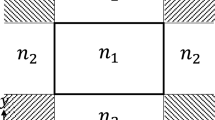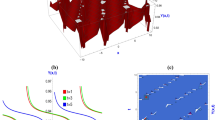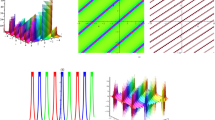Abstract
A nonlinear finite-difference time-domain (FDTD) formalism is developed to model dispersive second-order nonlinear effects in photonic arrangements and optical devices. The dispersion of the second-order nonlinear susceptibility, χ(2), is based on the Faust-Henry model, which makes no implicit assumption on the relationship between the linear and nonlinear dispersion. Unlike other models for χ(2) dispersion, the Faust-Henry model accurately describes a broad range of crystal classes, including the \( \overline{4}3m \) crystal class, which is essential to generating radiation in the terahertz frequency regime. As such, the developed formalism based on the Faust-Henry dispersion model overcomes limitations imposed by previous FDTD methods for modelling second-order nonlinear effects.






Similar content being viewed by others
References
D. H. Auston and M. C. Nuss, “Electrooptical generation and detection of femtosecond electrical transients,” IEEE J. Quantum Electron.24, 184–197 (1988).
R. L. Aggarwal and B. Lax, “Optical mixing of CO2 lasers in the far-infrared” in Nonlinear Infrared Generation, edited by Y.-R. Shen, Topics in Applied Physics16 (Springer, 1977), pp. 19–80.
A. Mayer and F. Keilmann, “Far-infrared nonlinear optics. I. χ(2) near ionic resonance,” Phys. Rev. B33, 6954–6961 (1986).
W. Ettoumi, Y. Petit, J. Kasparian, and J.-P. Wolf, "Generalized miller formulæ," Opt. Express18, 6613–6620 (2010).
M. Bell, “Frequency dependence of Miller's Rule for nonlinear susceptibilities,” Phys. Rev. B6, 516–521 (1972).
C. Garrett and F. Robinson, “Miller's phenomenological rule for computing nonlinear susceptibilities,” IEEE J. Quantum Electron.2, 328–329 (1966).
R. C. Miller, “Optical second harmonic generation in piezoelectric crystals," Appl. Phys. Lett.5, 17–19 (1964).
W. L. Faust and Charles H. Henry, “Mixing of visible and near-resonance infrared light in GaP,” Phys. Rev. Lett.17, 1265–1268 (1966).
S. Casalbuoni, H. Schlarb, B. Schmidt, P. Schmüser, B. Steffen, and A. Winter, “Numerical studies on the electro-optic detection of femtosecond electron bunches,” Phys. Rev. Accel. Beams11, 072802 (2008).
Y. J. Ding, "Efficient generation of high-frequency terahertz waves from highly lossy second-order nonlinear medium at polariton resonance under transverse-pumping geometry," Opt. Lett.35, 262–264 (2010).
M. Cherchi, A. Taormina, A. C. Busacca, R. L. Oliveri, S. Bivona, A. C. Cino, S. Stivala, S. R. Sanseverino, and C. Leone, “Exploiting the optical quadratic nonlinearity of zinc-blende semiconductors for guided-wave terahertz generation: a material comparison,” IEEE J. Quantum Electron. 46, 368–376 (2010).
D.E. Thompson and P.D. Coleman, “Step-tunable far infrared radiation by phase matched mixing in planar-dielectric waveguides,” IEEE Trans. Microw. Theory Tech.22, 995–1000 (1974).
C. M. Reinke, A. Jafarpour, B. Momeni, M. Soltani, S. Khorasani, A. Adibi, Y. Xu, and R. K. Lee, "Nonlinear finite-difference time-domain method for the simulation of anisotropic, χ(2), and χ(3) optical effects," J. Lightwave Technol.24, 624–634 (2006)
B. N. Carnio and A. Y. Elezzabi, "Second harmonic generation in metal-LiNbO3-metal and LiNbO3 hybrid-plasmonic waveguides," Opt. Express26, 26283–26291 (2018).
B. N. Carnio and A. Y. Elezzabi, "A modeling of dispersive tensorial second-order nonlinear effects for the finite-difference time-domain method," Opt. Express27, 23432–23445 (2019).
B. E. Schmidt, P. Lassonde, G. Ernotte, M. Clerici, R. Morandotti, H. Ibrahim, and F. Légaré, “Decoupling frequencies, amplitudes and phases in nonlinear optics,” Sci. Rep. 7, 7861 (2017).
I. Wilke and S. Sengupta, “Nonlinear optical techniques for terahertz pulse generation and detection-optical rectification and electrooptic sampling” in Terahertz Spectroscopy: Principles and Applications, edited by S. L. Dexheimer, 1st edn. (CRC Press, 2007), pp. 41–72.
Acknowledgements
The authors are grateful for the support provided by Optiwave Systems Inc., especially Scott Newman, Ahmad Atieh, and Kevin Chu, and for the access to Optiwave’s OptiFDTD simulation software platform.
Funding
This research was funded by the Natural Sciences and Engineering Research Council of Canada (NSERC). This work was performed under NSERC’s Engage grant program in collaboration with Optiwave Systems Inc.
Author information
Authors and Affiliations
Corresponding author
Additional information
Publisher’s Note
Springer Nature remains neutral with regard to jurisdictional claims in published maps and institutional affiliations.
Rights and permissions
About this article
Cite this article
Carnio, B.N., Elezzabi, A.Y. An Extensive Finite-Difference Time-Domain Formalism for Second-Order Nonlinearities Based on the Faust-Henry Dispersion Model: Application to Terahertz Generation. J Infrared Milli Terahz Waves 41, 291–298 (2020). https://doi.org/10.1007/s10762-019-00666-1
Received:
Accepted:
Published:
Issue Date:
DOI: https://doi.org/10.1007/s10762-019-00666-1




